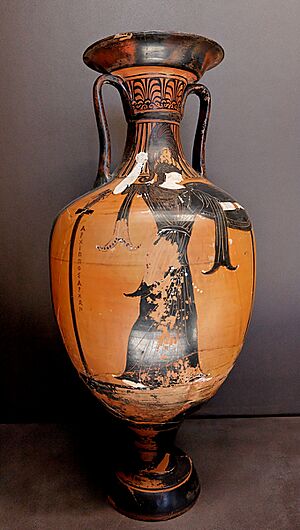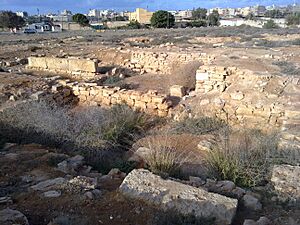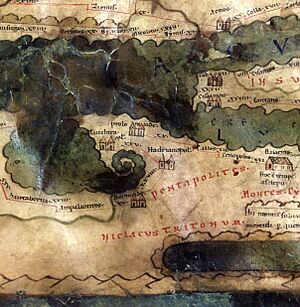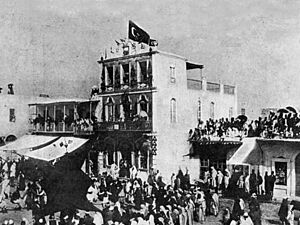History of Benghazi facts for kids
Libya's second largest city, Benghazi, has a very long and interesting history. It started as a Greek colony called Euesperides way back in the 6th century BCE. Over time, many different groups and empires have taken control of the city.
Contents
Ancient Greek City of Euesperides

Modern Benghazi is in an area called Cyrenaica. Long ago, many Greeks settled here. The Greek city that became Benghazi was founded around 525 BCE.
It was known as Euesperides or Esperis. It was one of five important Greek cities in Cyrenaica, called the Pentapolis. The other four cities were Cyrene, its port Apollonia, Taucheira, and Barca. Euesperides was likely started by people from Cyrene or Barca. It was built next to a lagoon that connected to the sea. The name Euesperides meant "good Hesperides" because the area was very fertile. It was even linked to the mythical garden of Hesperides. The city was located on a raised piece of land in what is now the Es-Selmani area of Benghazi.
Euesperides is first mentioned by the ancient historian Herodotus around 515 BCE. He wrote about the Persian army reaching "as far west as Euesperides." The oldest coins from the city are from 480 BCE. One side of the coin showed Delphi, and the other showed a silphium plant. Silphium was a very important plant for trade in Cyrenaica. It was used as a rich seasoning and a medicine. Euesperides' coins suggest it was sometimes independent from Cyrene.
The city was in a difficult area, surrounded by unfriendly tribes. It had a troubled history. The Greek historian Thucydides wrote about a siege of the city in 414 BCE. Libyan tribes, probably the Nasamones, attacked it. Euesperides was saved by chance when the Spartan general Gylippus and his fleet arrived. They were blown to Libya by strong winds on their way to Sicily.
Another big event was the killing of the Cyrenean king Arcesilaus IV. After winning a chariot race in 462 BCE, the King invited new settlers to Euesperides. He hoped to find safety there from his own people in Cyrene. But this didn't work. When a revolution started around 440 BCE, the King fled to Euesperides and was killed. This ended the Battiad family's rule, which had lasted almost 200 years.
Cyrenaica supported Alexander the Great and later became part of the Ptolemaic Kingdom. In the late 4th century BCE, after Alexander's death, Euesperides supported the losing side in a revolt. This revolt was led by a Spartan adventurer named Thibron. He was trying to create his own empire but was defeated.
Later, around the mid-3rd century BCE, Ptolemy III married Berenice. To celebrate, many Cyrenaican cities were renamed. Euesperides became Berenice. The city also moved to a new location. The old site was likely abandoned because the lagoons became too shallow. The new city of Berenice is under Benghazi's modern city center. The Greek colony lasted from the 6th to the mid-3rd centuries BCE. The remains of this old settlement were found in the early 1950s.
Roman Settlement
Cyrenaica became a Roman province when Ptolemy Apion left it to Rome after he died in 96 BCE. At first, the Romans gave Berenice and the other Pentapolis cities their freedom. But by 78 BCE, Cyrenaica was officially part of the same province as Crete. It became a special province in 20 BCE.
Later, around 296 CE, the Roman emperor Diocletian changed the way the empire was organized. Cyrenaica was split into two provinces. Berenice was in Libya Superior. Berenice did well for most of its 600 years as a Roman city. It even became more important than Cyrene and Barca after the 3rd century CE. Many buildings were constructed in Roman Berenice. Important buildings had beautiful mosaic floors. Public baths and churches were also built later.
People in the city followed different religions over the centuries. In ancient times, people in Berenice greatly worshipped Apollo. Even when it was a pagan city, a Jewish community lived there. They had moved from the Euesperides site. Three Jewish writings found in Benghazi show that some Jewish people were quite wealthy. There was also a synagogue in Berenice.
Christianity came to Berenice from Egypt. Many early Christians there had different beliefs. After the Council of Nicaea in 325 CE, Cyrenaica was recognized as a Christian area under the See of Alexandria.
By 431 CE, the Vandals conquered all of Libya. These Germanic people from Europe quickly invaded the country. Their leader, Geiseric, brought many settlers with him. They attacked Cyrenaica in the 5th century, and Berenice became part of their empire. The Romans accepted Vandal rule, but Roman officials still managed the city. Berenice was greatly damaged during the Vandal invasion.
There was a short period of rebuilding when the Eastern Roman Empire (also called the Byzantine Empire) took control of Berenice in the 6th century. The city was ruled by Justinian I. According to a historian named Procopius, Justinian rebuilt the walls of Berenice and also built a public bath. Later, under Emperor Maurice (582-602 CE), Cyrenaica became part of the province of Egypt.
However, Byzantine control over the region was generally weak. This was especially true outside of cities like Berenice. Rebellions by local Berber tribes were common. This led to a lot of chaos in the area. The city's chance to become prosperous was lost. Byzantine rule was not popular, partly because taxes were greatly increased. This money was used for the military, but Berenice and other cities were left to fall apart.
The Arabs and the Arrival of Islam
Islam came to North Africa when there was little strong opposition. Many local people were open to its arrival. The Romans had mostly disappeared, except in Berenice and other small areas under Byzantine rule. Life in Berenice was almost gone. This was due to people leaving the city and fierce fighting in the 2nd century. The towns were empty and attacked by groups of Berbers. Berber farmers were heavily taxed and wanted new rulers. The official Church had also upset many people with its strict views.
In 642 CE, a peace agreement was made between 'Amr ibn al-'As and the Byzantine governor of Egypt. This agreement confirmed that the Arabs had conquered Egypt. Soon after, on September 17, 642, the last Byzantine soldiers left Alexandria.
Amr ibn al-As, who conquered Egypt, decided to also take Cyrenaica. Since Emperor Maurice's changes (582-602 CE), Cyrenaica had been part of the province of Egypt. Amr marched into Cyrenaica in early 643 CE. He took control almost without any fighting. He found no Greeks or Byzantines to oppose him, only Berber groups. These groups surrendered and agreed to pay a yearly tax.
By then, Berenice had become a very small village among grand ruins. It started to be known by its Arabic name, Barneeq.
In the 13th century, this small settlement became important for trade. Merchants from Genoa traded with the tribes in the area. On maps from the 16th century, the name Marsa ibn Ghazi appears.
Ottoman Rule
Benghazi had a very important port location. The Ottomans could not ignore it. They took control of Benghazi in the 16th century. It was ruled from Tripoli by the Karamanlis from 1711 to 1835. Then, it came under direct Ottoman rule until 1911.
Under Ottoman rule, Benghazi was one of the poorest Ottoman provinces. It had no paved roads or telegraph service. The harbor was too shallow for large ships to enter. Greek and Italian sponge fishermen worked in its coastal waters. In 1858 and again in 1874, Benghazi was badly affected by the bubonic plague.
Italian Invasion
In 1911, the Italians invaded Benghazi. By 1912, they had set up the colony of Cyrenaica. The local people of Cyrenaica, led by Omar Mukhtar, fought against the Italian occupation. Cyrenaica suffered greatly, especially under the harsh rule of the fascist leader Mussolini. About 125,000 Libyans were forced into camps. Many of them died there.
The Italians modernized and made the port bigger. They also developed the city. They built a new area with white Italian-style villas and other buildings near the shore. Benghazi grew as a center for government and business. By the start of World War II, about 22,000 Italians lived there.
Modern Benghazi
Benghazi was heavily bombed during World War II. Later, it was rebuilt using the country's new oil wealth. It became a shining example of modern Libya.
On April 15, 1986, US Air Force and Navy planes bombed Benghazi and Tripoli. President Ronald Reagan said the attacks were justified. He claimed Libya was responsible for terrorism against the USA. This included the bombing of a discotheque in West Berlin ten days before.
In February 2011, Benghazi was a place of protests against the Gaddafi government. These protests led to many deaths caused by security forces. Houses of people suspected of being against the government were burned. By late February 2011, Benghazi was no longer controlled by the government in Tripoli. It was under the National Transitional Council of Libya.
After the Gaddafi government was overthrown, the city faced a lot of instability. This was due to weak temporary governments. There was also a split between the Tripoli-based government and the Libyan National Army. Fighting broke out between different armed groups. Islamist militant groups also reappeared.
In 2012, Benghazi became a focus of attention in the United States. The American diplomatic mission in Benghazi was attacked by a large group of armed Islamist gunmen. The start of the second Libyan Civil War in 2014 also saw heavy fighting in and around Benghazi. The fighting was between the Libyan National Army and Islamist groups. The Libyan National Army declared the city cleared of these groups on July 5, 2017. The fighting officially ended on July 27.
See also
- Timeline of Benghazi
Sources





